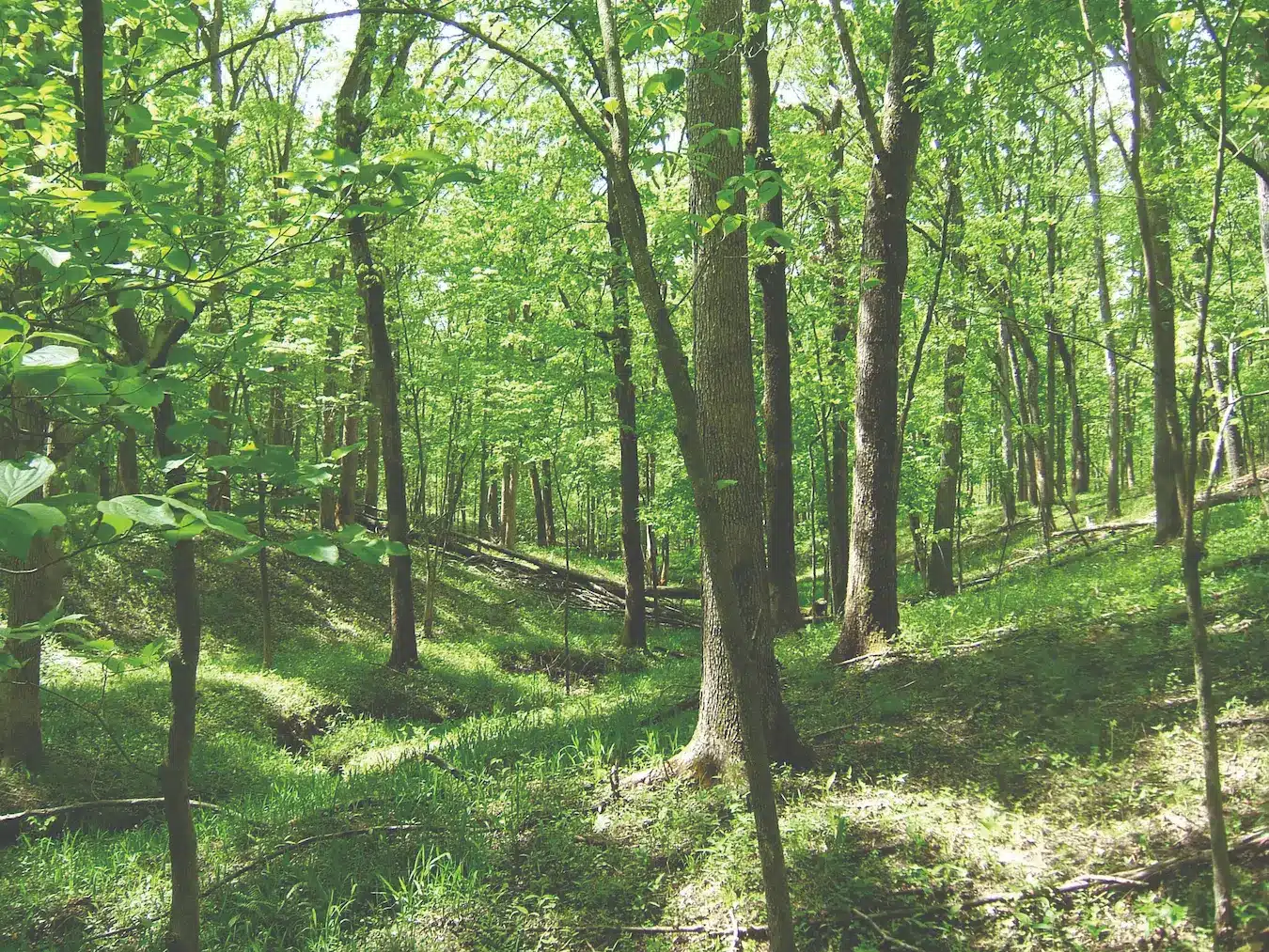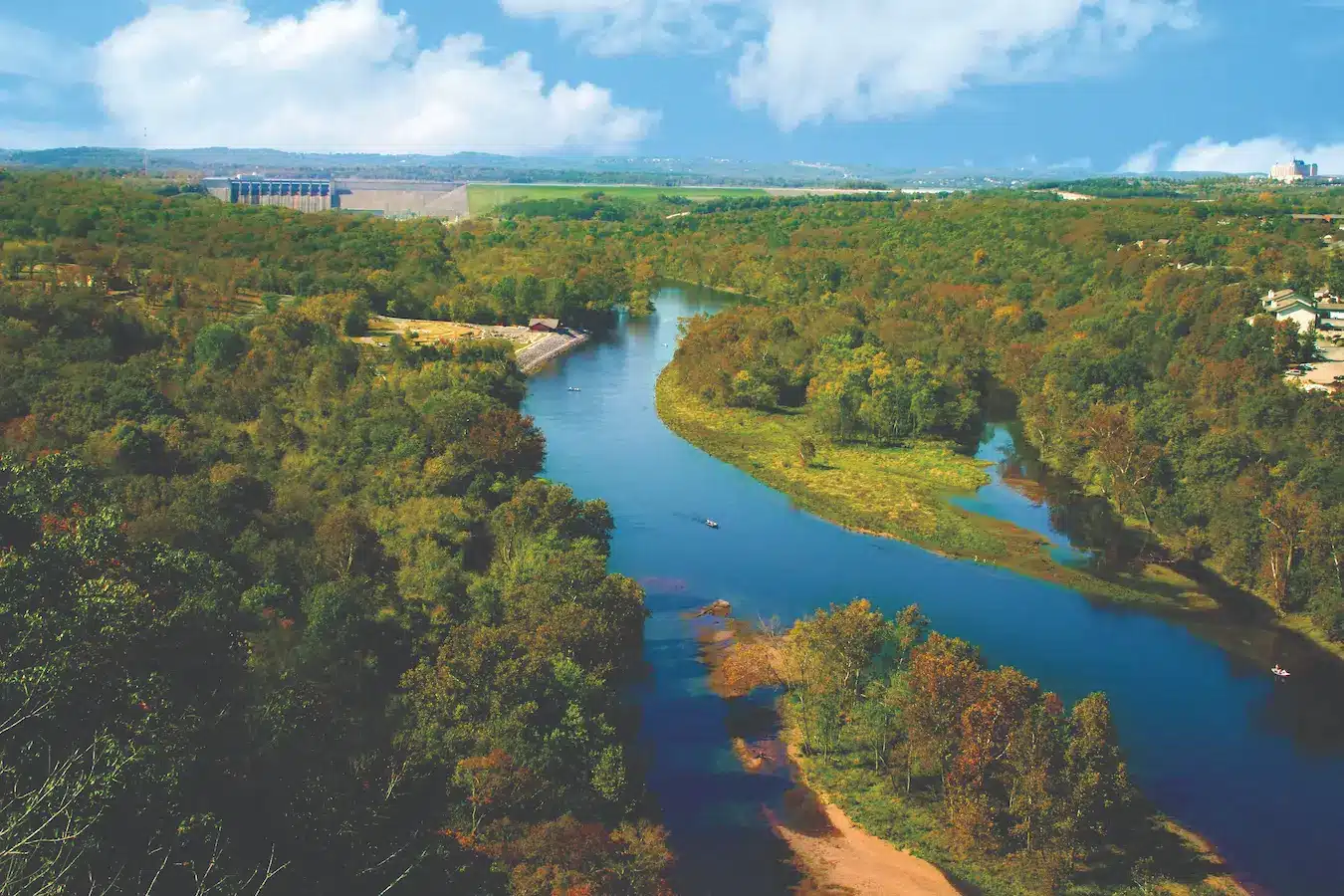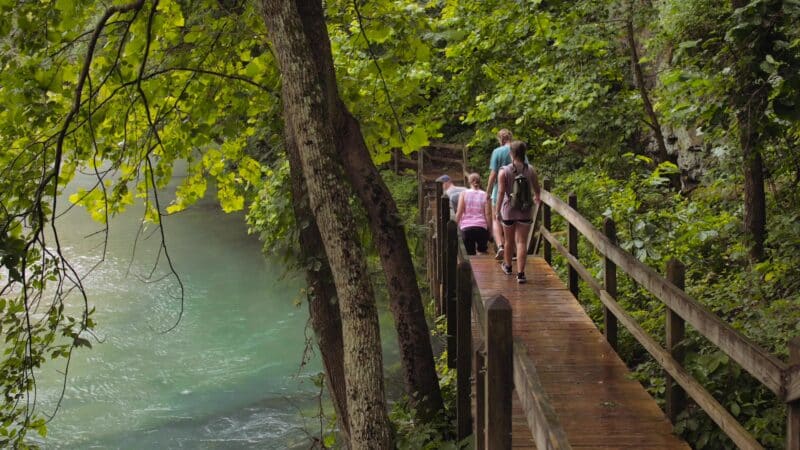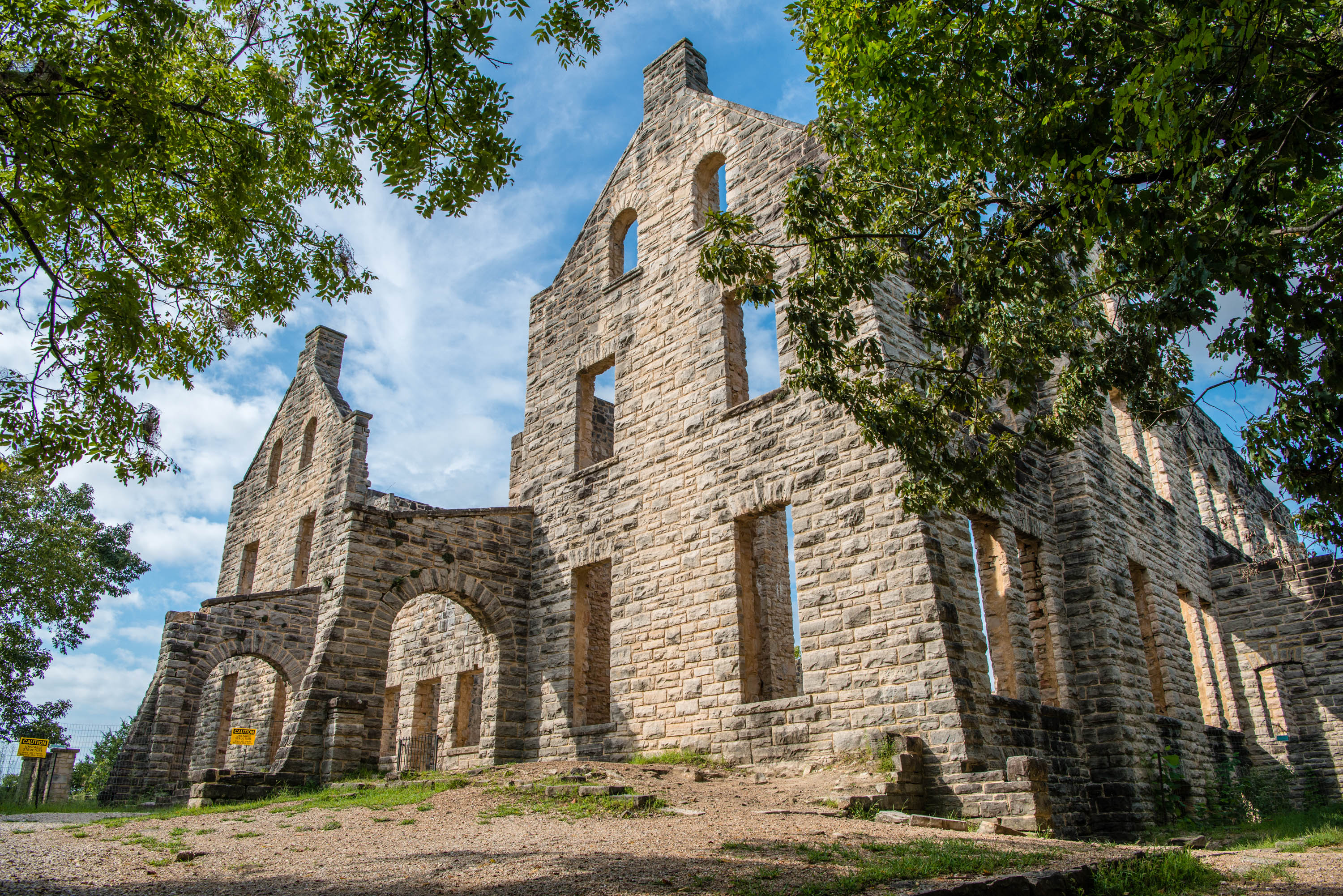A collection of caves and underground streams. Osage influence. Historical ties to a ring of outlaws. Crumbling castle ruins. Tales of a curse. The only thing bigger than the views at Ha Ha Tonka State Park are the stories you’ll hear.
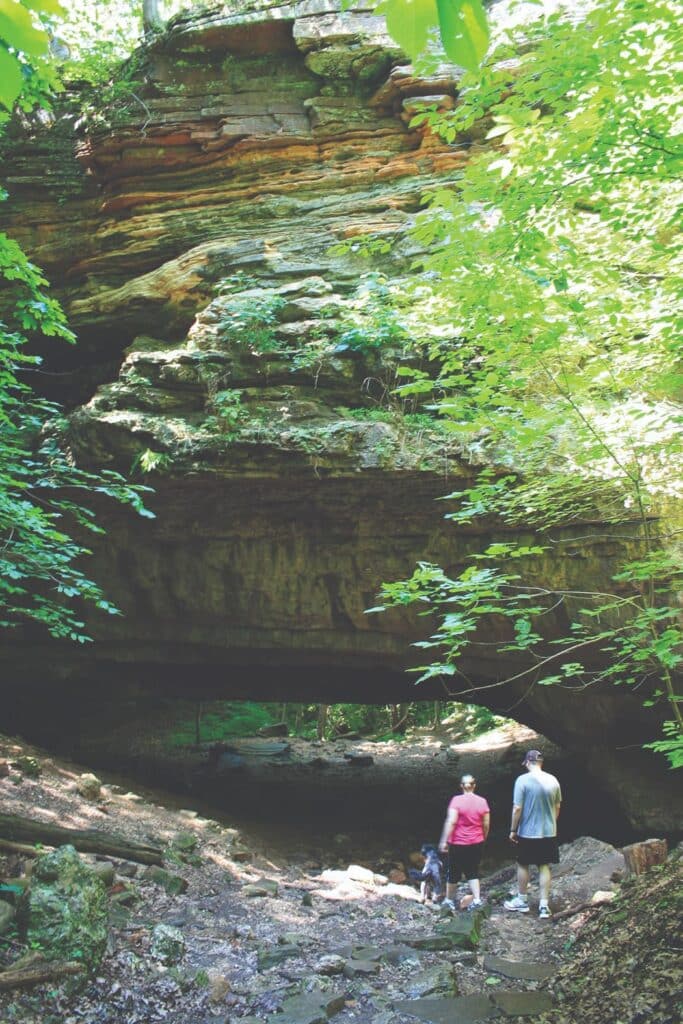
Photo by Nancy Masterson
Nearly seventy years passed after Ha Ha Tonka was initially proposed as a park before it was finally acquired by the state. A Missouri representative had promoted the area in Camden County as a national forest in 1903, and Gov. Herbert S. Hadley recommended it to become Missouri’s first state park in 1909. Then in 1915, a special committee of the state legislature, appointed to investigate sites for potential state parks, recommended Ha Ha Tonka as its first choice. Other attempts at state purchase were made during subsequent years, all to no avail. The property changed hands frequently, with many owners failing to realize their development dreams. As one St. Louis realtor and conservationist pointed out, the tract seemed cursed. But in 1978 the curse was broken, and Ha Ha Tonka became Missouri’s sixty-first state park.
Ha Ha Tonka contains Missouri’s most outstanding examples of karst topography, named for the Karst region in the Balkans but characteristic also of the limestone-laden Ozarks. Here is found a honeycomb of tunnels, caverns, springs, sinkholes, and other limestone features created by water dissolving the soluble rock. The park also contains the state’s best examples of glades, open areas with exposed bedrock dominated by drought-adapted herbs and grasses. Ha Ha Tonka is mantled in grasslands, occasionally shaded by oaks; these oak orchards, as some call them, were once one of Missouri’s most widespread natural communities but are now among the least common.
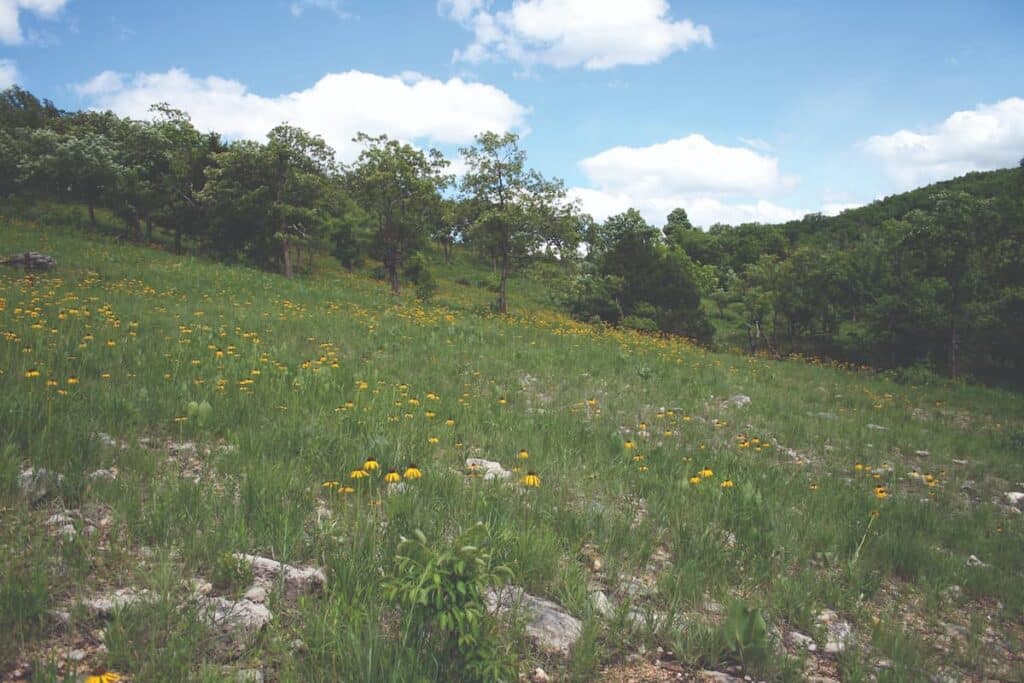
Photo by Nancy Masterson
No other state park has a more fascinating, if convoluted, history. Native Americans, early explorers, frontiersmen, outlaws, turn-of-the century capitalists, and twentieth-century real estate speculators are all part of the park’s history and folklore. And for good measure, it offers the storybook ruins of a castle.
For vintage Missouri hyperbole, consider the praise lavished on Ha Ha Tonka by Dr. Walter Williams, founder of the journalism school at the University of Missouri, who would later undertake the naming of Missouri’s seven scenic wonders—Ha Ha Tonka being number one. Having visited the area many times beginning in the 1870s, he wrote that it contained “more natural curiosities than in any other similar share of the earth’s surface” and chastised Missourians for their obliviousness:
If Hahatonka were on a railroad it would have thousands of visitors where now it has one. Here is a cave more wonderful than Mammoth Cave, a spring surpassing in size any in the State, a natural bridge superior to the famous Virginia Natural Bridge .… Yet Missourians will wander off to the distant sections of the country to see caves, waterfalls, lakes, and mountains far inferior in beauty.
It is little wonder that the Osage and other tribes frequented the area. It remained Osage territory until the early nineteenth century, when most of their lands were ceded to the federal government. Early white visitors likely included Daniel and Nathan Boone, who spent the winters of 1801 and 1802 trapping beaver along the Niangua River, and Lt. James B. Wilkinson of the Pike Expedition, who described it in his official report. Legend says a band of counterfeiters, the infamous “Bank of Niangua,” used the area in the 1830s and that the gang’s leader, a fellow named Garland, built a gristmill on the spring branch.
During a railroad survey around 1894, Col. R.G. Scott explored the area and, taken with its beauty, amassed a large tract in partnership with a Civil War comrade from the area. Local residents petitioned the postmaster general in 1895 to name the new post office at the settlement near the spring Ha Ha Tonka. The name was supposedly derived from Osage words meaning “smiling waters,” though others say the words in Osage would be closer to “big laugh.”
High on a bluff overlooking the spring and the Niangua River—now the Niangua arm of Lake of the Ozarks—are the ruins of a massive stone mansion and its companion structures. Giving the park the look and mood of a backlot for the filming of a Gothic romance, these ruins represent what is probably the most intriguing episode in Ha Ha Tonka’s fascinating history. They also represent the origin of the supposed curse.
Robert M. Snyder, a wealthy businessman from Kansas City, first visited the area in 1903 on a hunting trip. He stayed at a hotel in nearby Lebanon, where he learned about the wonders of Ha Ha Tonka. Immediately captivated, Snyder set out to acquire some sixty different tracts of land, beginning with the tract that included the spring and eventually totaling more than 5,000 acres. He envisioned a private retreat with a huge, European-style castle, which was designed for him by Kansas City architect Adrian VanBrunt. With native stone quarried on the site and stonemasons from Scotland, the 85-by-115-foot structure began taking shape in 1905. In addition, an 80-foot-high stone water tower was constructed, and greenhouses and stables were designed and begun. Snyder apparently intended to spare no expense, as everything about the project was on a grand scale.
But in 1906, Snyder was killed in an automobile accident. All work at Ha Ha Tonka ceased, and the fate of the place was in doubt. A group of St. Louis investors came close but ultimately did not buy the unfinished property for $156,000. Eventually, Snyder’s sons finished the castle, though not to their father’s sumptuous specifications. Still, it was a luxurious white elephant, and they tried repeatedly to unload it on the state—for $160,000, $200,000, $300,000—always more than the state could afford. Using the mansion as a summer home, the Snyder family sued Union Electric when Bagnell Dam, completed in 1931, backed the Lake of the Ozarks up the spring branch. The Snyders settled out of court for $200,000. As the years passed, they used the home less and less, finally leasing it as a summer hotel. Tragedy struck again in 1942 when the wooden shingles on the roof of this supposedly fireproof building caught fire and the entire interior was gutted. The crumbling stone walls have maintained a lonely vigil ever since.
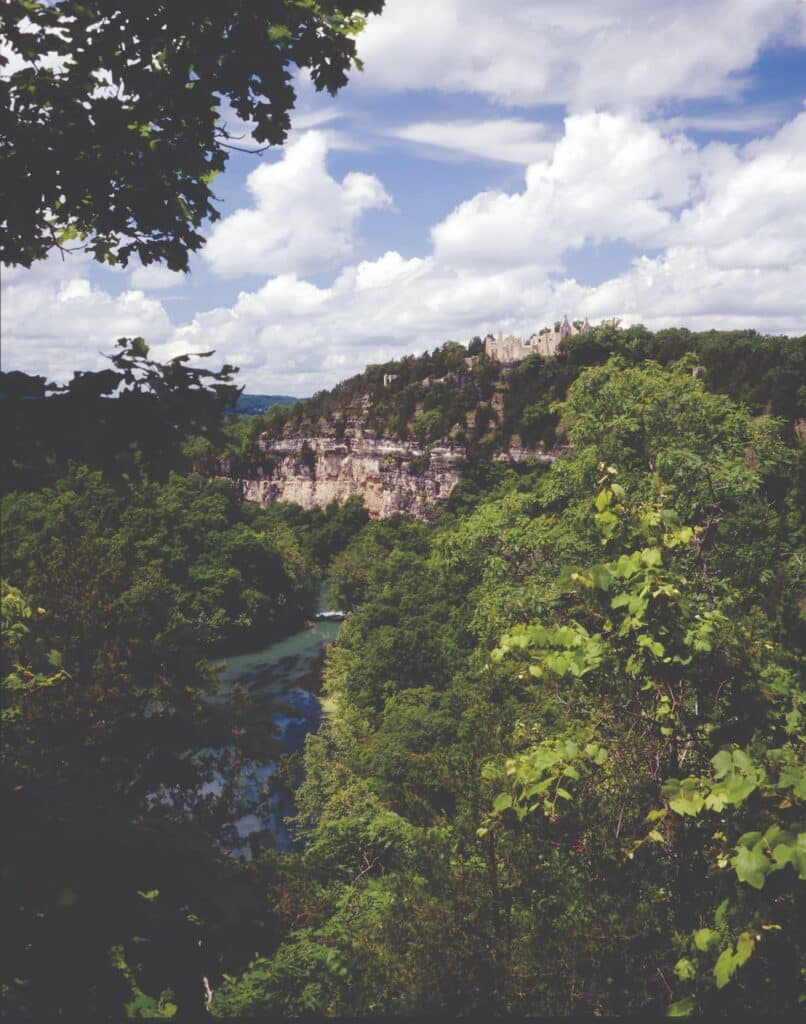
Photo courtesy of Susan Flader
After the fire, the property changed hands several times, with each new owner planning to cash in by commercializing its natural wonders. Various groups tried unsuccessfully to purchase the land as a park or refuge or Scout camp. Each succeeding owner did little with the property except cause the price to rise. Meanwhile, the area was prey to trespassers, and many of the structures were vandalized. Shortly before the state acquired the land, the watertower was burned. But in 1978, with a grant from the federal Land and Water Conservation Fund and a sizable donation that allowed a tax write-off for its owner, the James T. Barnes Investment Company of Detroit, the entire 2,500-acre tract (then valued at nearly $2 million) finally became a state park.
Governor Hadley’s effort to secure a $160,000 appropriation for the park in 1911 had failed by one vote; having cleared the Missouri Senate, the measure died in the House. Other governors failed as well, including Frederick Gardner in 1921 and Phil M. Donnelly in 1947. So Gov. Joseph Teasdale had every right to be proud when he announced in December 1978 that the state had finally acquired the fabled Ha Ha Tonka—and for just about the same dollar amount of state funds as the failed appropriation of 1911.
Since the site’s acquisition by the state, it has become apparent that its scenic grandeur and the saga of the castle, however appealing to the public, are not the park’s only claims to significance. In a single square mile, the park contains more classic karst features—caves, springs, chasms, sinkholes, underground streams, and natural bridges—than any other place in the state. The park has several major caves and other smaller ones with numerous passages, underground streams, and exemplary formations, including River Cave with an underground natural bridge and an immense columnar stalagmite thirty feet high and twenty-four feet in circumference. There is also a natural bridge on the surface spanning sixty feet with a ceiling height of thirteen feet, and numerous water-carved cliffs, sinks, and springs exposed to the surface when the roofs of other parts of the cave system collapsed. By no means least of the park’s geologic wonders is the Ha Ha Tonka Spring, counted among the state’s dozen or so largest springs and discharging an average of some fifty million gallons of fresh, cold water every day. Mantling the rugged topography are the finest and largest natural oak woodlands and glades in the state—a wildflower-carpeted wonderland with over five hundred species of plants harkening back to pre-settlement times in the western Ozarks.
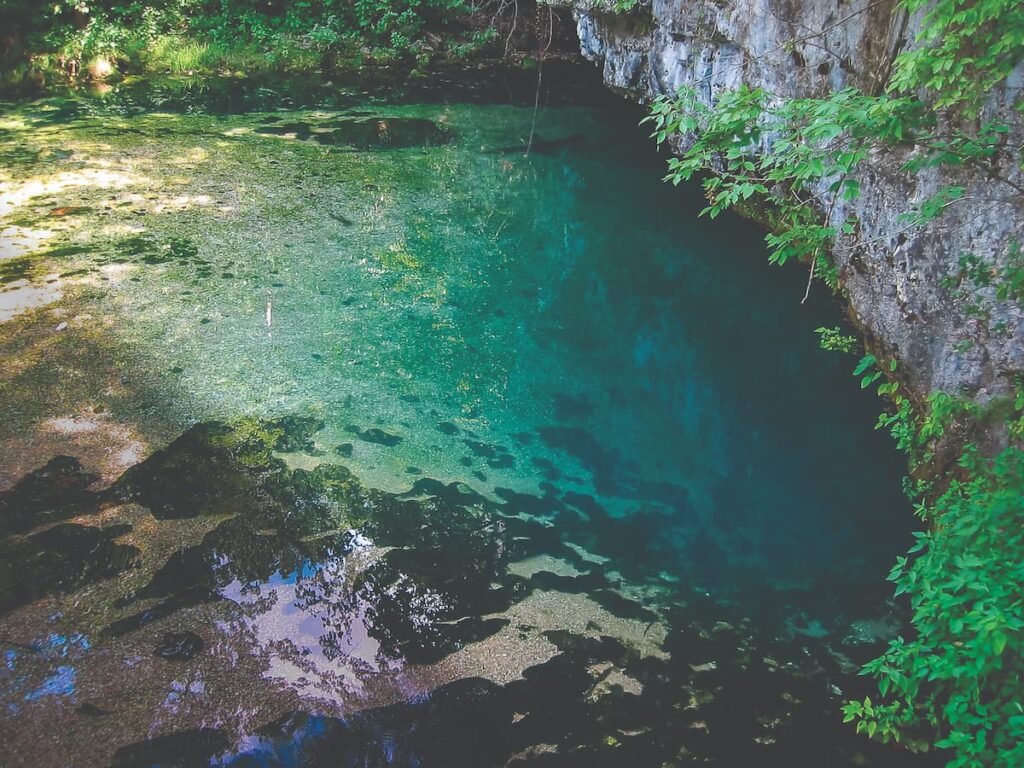
Photo by Randal Clark
Repeated fires, naturally occurring and set by native tribes, gave this landscape its special character. For centuries, periodic fire shaped a mosaic of post, white, chinkapin, and blackjack oaks and other species into a harmonious intermingling of open rocky glades, grasslands with
widely spaced individual trees, or open woodland on steep north-facing slopes where fire is somewhat less frequent. The post oaks and, to a lesser degree, other oaks have evolved bark thick enough to protect their trunks from fire, while their limbs sprawl just out of harm’s way. Beneath the oaks flourish prairie plants—tallgrasses such as big bluestem, Indian grass, and little bluestem and myriad prairie wildflowers, sometimes as many as two hundred species on a single acre.
Animal life in this fire-dependent landscape is equally diverse. Prior to white settlement, the once extensive woodland zone stretching along the eastern plains from Texas to Wisconsin was home to many species that are today associated with brushy thickets and the woodland edges of fields. The eastern bluebird (Missouri’s state bird), cardinal, redheaded woodpecker, prairie warbler, screech owl, and many other species prefer open natural orchards to denser forests. Tree hollows, created by insects, bacteria, and fungi that enter trees scarred by fire, provide refuge for nearly a hundred species of cavity-nesting vertebrates. Flying, gray, and fox squirrels, raccoons, opossums, broad-headed skinks, chipmunks, and certain bats are plentiful here.
The oak woodland is in part a cultural landscape. For thousands of years, American Indians used fire presumably for practical reasons: to make hunting better, to promote berry and fruit production, and to prevent acorn weevils from destroying acorns—a precious food source for humans and animals alike. After white settlement, the open woodlands were converted to farmland, and fire prevention allowed various woody species to form thickets. But in this rough region of the Ozarks, a tradition of woods burning persisted despite the best efforts of conservation officials to stamp it out, thus unintentionally preserving vestiges of the woodland community. Indeed, coring samples from old trees in the park suggest that fires burned the area every five to twenty years for millennia. Since 1983, park staff have introduced a prescribed fire program and have worked closely with conservation officials to educate local citizens about the use of controlled burning to restore a biologically unique and valuable component of Missouri’s presettlement heritage.
Shortly after the park was acquired by the state, three small natural areas were designated in 1981 by the Missouri Natural Areas Committee: Red Sink, an eight-acre sinkhole with a mature sinkhole-floor forest; Lodge Glade, a 20-acre dolomite glade with several calcareous sinks; and Ha Ha Tonka Karst, a 70-acre collapsed cave system with a natural bridge, caves, springs, and sinkholes. Then, after park naturalists introduced prescribed fire in portions of the glades and oak woodlands, the response of the natural ground flora was so remarkable that by 1990, a 953-acre area won designation as the Ha Ha Tonka Savanna Natural Area. In 2012 this area was expanded to nearly 3,000 acres as the Ha Ha Tonka Oak Woodland Natural Area, which incorporates each of the previously designated natural areas in the park and encompasses each part of the park that is managed with prescribed fire. The park’s geologic and natural history features are so significant that it has also been nominated as a National Natural Landmark, the highest level of national designation, which has been accorded to only three other state parks—Big Oak Tree, Onondaga Cave, and Grand Gulf. Ha Ha Tonka, if it wins designation in the exhaustive process, would be the largest landmark site in the park system and the only one interrelating geological, biological, and cultural significance.
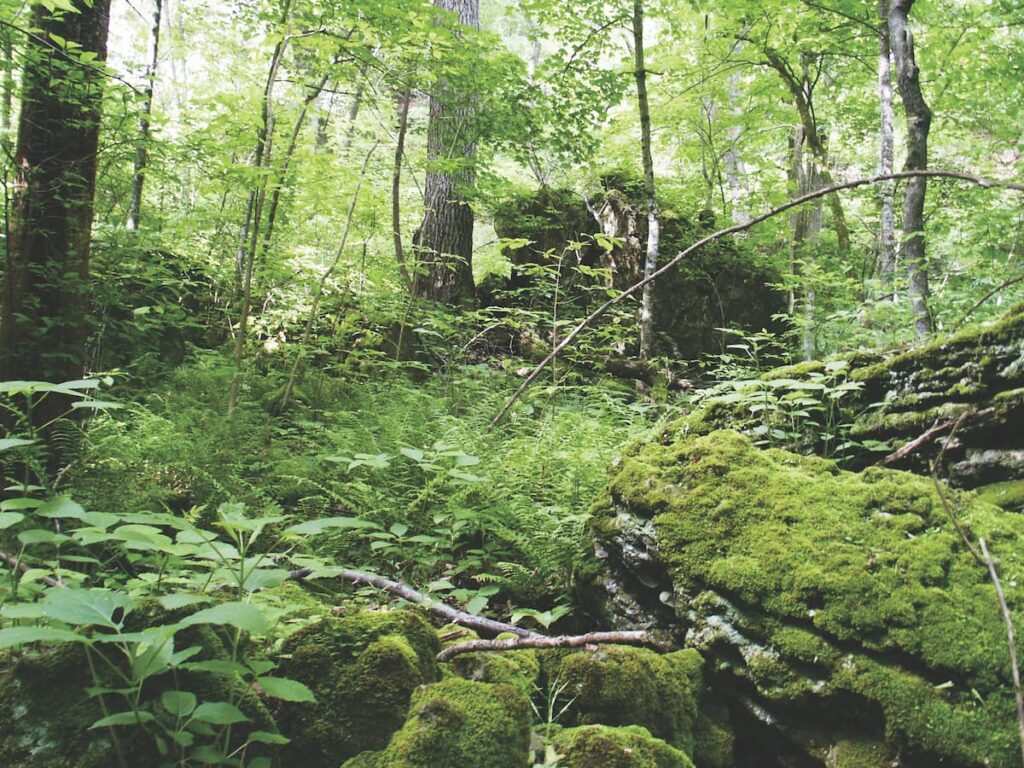
Photo by Paul Nelson
In addition to its continuing landscape stewardship program, the park division has invested nearly a million dollars in the highly professional but virtually invisible stabilization of the castle ruins so beloved by visitors. Without the sophisticated post-tensioning technique using steel plates and reinforcing rods bonded several feet deep into the bedrock with epoxy cement as tension devices to stabilize the stone walls, it would only have been a matter of years before the castle was reduced to a pile of rubble. Considering the lengths to which park designers and estate planners in the nineteenth century went to deliberately create false ruins in the landscape, as at Tower Grove Park in St. Louis or Andalusia outside Philadelphia, it is perhaps not surprising that Missourians should want to preserve the real ones so spectacularly situated at Ha Ha Tonka.
The park’s karst features have also been protected. Visitors used to cause damage by climbing the scarps to the springs, cliffs, and bluff-top castle. Today, a series of boardwalks and stairs give them better access. You can now descend into River Cave or climb from the spring to the castle on wooden steps. The boardwalk going up over the cliff at the spring is a truly amazing sight—316 steps to the top.
Even without campgrounds, cabins, or a restaurant, and with only a small open-air informative pavilion, the 3,752-acre Ha Ha Tonka is a remarkably popular park, with more than half a million visitors annually. Ha Ha Tonka is a wonderland that will not disappoint.
Feature image photo by Ken McCarty.
Related Posts
Missouri State Parks Lead Efforts to Restore Our Natural Landscapes.
A great effort is underway to restore our natural prairies, glades, woodlands, and marshes. Learn how this is being done and where you can see these restored areas. And read about how the owners of Missouri Life are creating natural habitat on their farm.
Enjoy the Beauty of Table Rock State Park
Table Rock State Park is indeed worth a visit. It provides the perfect access to a storied region. You may enjoy the abundant tourist attractions of Branson, but when you need a break, you can hike the park trails or find along some backwoods byways much that is still unspoiled and inviting in the White River Hills.
Discover Pleasures at the Lake of the Ozarks
Come along with the host of Missouri Life TV as she learns how to wakeboard at the Lake of the Ozarks, takes a tour of the dam, and visits Ha Ha Tonka State Park’s magnificent ruins as well as a cave that has hosted more than 4,000 weddings.
Ha Ha Tonka Builder Killed in Auto Accident
On August 30, 1904, the Great Olympic Marathon debacle unfolds at the Summer Olympic Games in St. Louis, Mo.

